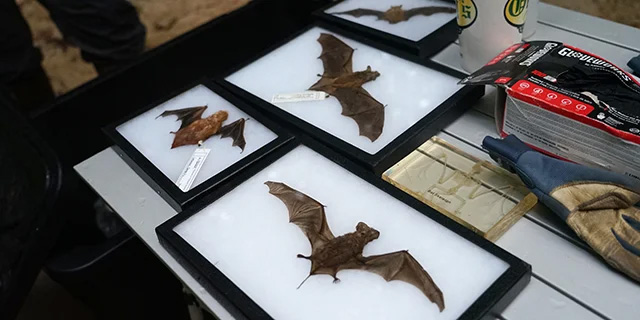Largest group of bat surveyors to visit Mississippi in two decades net 32 new records
Published 9:15 am Saturday, August 10, 2024
The largest group of bat surveyors in Mississippi’s Bat Working Group in 21 years recently paid a visit to Adams County and the surrounding area to document, learn and share information about the various bat species living here.
The 21st annual event brought 50 participants here on July 25 and 26 from eight states and featured a training focused on the identification of Mississippi’s bat species and guidance on listed species and the survey guidelines provided by the US Fish and Wildlife Service.
The first night, nets were set up on the Natchez Trace Parkway and Canemount Wildlife Management Area in Port Gibson. On night two, surveyors netted at the Homochitto National Forest and participants toured St. Catherine’s Creek National Wildlife Refuge, visiting artificial roosts with Rafinesque’s big-eared bats and birding around the refuge’s wetlands.
Participants also took a field trip to a culvert roost in Claiborne County, north of Natchez, to see over a dozen northern long-eared bats.
Bats have an unfortunate un-earned bad reputation for carrying rabies, which is carried in less than 1 percent of the population but is “a serious, fatal disease so you definitely don’t want to pick them up,” said Alison McCartney of the U.S. Department of Wildlife Fisheries and Parks and Chair of Mississippi Bat Working Group.
But a large surveying team recently visited Adams County and the surrounding area to learn and educate people on the various species and learn the helpful benefits of having them.
“People are just now beginning to realize the benefits,” McCartney said. “All Mississippi bats are insectivores and eat mosquitoes and agricultural pests. Organic farmers will sometimes put up bat houses to attract bats as a natural pesticide. Vampire bats in Texas have an anticoagulant protein in their saliva used in medicine to help heart and stroke patients. Fruit-eating bats in Asia and Australia act as seed dispersers and help to reforest. Their diet alone provides a lot of benefits to us.”
This year brought a diverse team to Natchez that included private organizations, consultants, government agencies and a few students interested in learning about bats.
“It’s the biggest event that we’ve had in the 21 years we’ve been doing it and the most states represented. We were able to visit 11 sites in two nights, which would take a lot longer without a group as big,” McCartney said.
The surveying lasted from around 6 p.m. to midnight each night. “It wasn’t quite as fruitful as we were hoping” but not a total loss either, McCartney said.
The group managed to capture four red bats and five evening bats — both of which are common species here — as well as one Seminole bat, one big brown bat and one tri-colored bat for a total of 12 captured. All were released safely and unharmed.
The tri-colored bat is proposed for federal listing as endangered, McCartney said.
“The more information we can get on all bat species, the better we can protect them and educate others about them,” McCartney said. “The main goal of these events is to create and outreach educational opportunity and also to collect data. … We invited everyone to come, including folks new to bat work, as a teaching opportunity.”
The Bat Working Group visits a different part of the state every year but were particularly interested in surveying the Natchez-Adams County area this year because of the possibility of finding a northern long-eared bat, which was recently listed as endangered because of the deadly white-nose syndrome.
While native to the northeastern United States, these bats were documented further south and thought to be migrating here, which could hypothetically give them a better chance of survival with a shorter hibernation period than their northern relatives.
“White-nose syndrome has decimated populations in cold climates where they go into true hibernation,” McCartney said. “There has been a 99 percent decline.”
While they didn’t find or document any northern long-ear roosts this time, more of these bats were documented in last year with extensive surveying efforts, McCartney said.
“From the 1930s to last August, we only had three records. Last August, we found two new roosts. We started doing intensive survey efforts around that area and came up with 32 new records.”
McCartney encouraged anyone interested to participate in future bat surveying and conservation efforts of the Mississippi Bat Working Group.
“You don’t’ have to be a bat person to get involved,” she said, adding anyone interested can contact the MDWFP Jackson Field office at 601-432-2400 or email msbats@hotmail.com.





